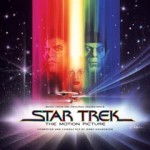 Last week La La Land Records released its 3-disc CD soundtrack to Star Trek: The Motion Picture. All I can say is, “it’s about time!”
Last week La La Land Records released its 3-disc CD soundtrack to Star Trek: The Motion Picture. All I can say is, “it’s about time!”
More than 30 years after the film’s release and the initial soundtrack release, and more than 10 years after the 20th anniversary, special edition release of the soundtrack score, it’s amazing to me how many more surprises and goodies were there were left to be included in this new release.
For $34.98 from the La La Land Records website, this is a STEAL!
For the first time ever you get the full score to Star Trek: The Motion Picture by Jerry Goldsmith, but that’s just the beginning. The release is chock full of so many extra tidbits that you could spend days analyzing all the new material.
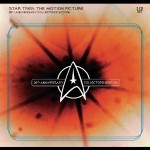
The 20th Anniversary Score
But let’s start at the beginning. The full score, as presented, never sounded better. While the 20th anniversary release WAS an expanded score, it was still missing many pieces of music from the film. Most notably, the Captain’s Log pieces, written by Alexander Courage and featuring his theme from the orignal series. As it turns out (according to the extensive liner notes), Jerry Goldsmith agreed to do the film provided he was not forced to use the theme. After agreeing that it made sense to use it during the “Captain’s Log” sequences, he asked Courage to provide the music for him. This is actually old news.
What’s INCREDIBLE and new news, is that Fred Steiner also composed a number of pieces of music for the film. Steiner, amongst other accomplishments, is known for providing music for many memorable episodes of the original Star Trek series including “The Corbomite Maneuver”, “Charlie X” and “Balance of Terror”. The idea that he was allowed to adapt Goldsmith’s compositions for this film is amazing to me, but what’s even more amazing is that once you know this fact, it becomes so much easier to hear the stylistic differences that Steiner brings to the table.
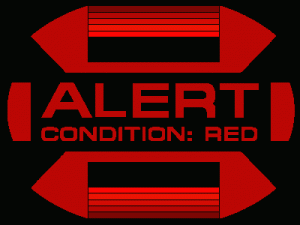 One of his compositions, “Meet V’Ger” is heard when the Enterprise is put on Red Alert having encountered the cloud for the first time. There are moments (however brief) that are evocative of the sound of the original series. Another interesting connection is that Steiner is responsible for a piece of music called “A Good Start”.
One of his compositions, “Meet V’Ger” is heard when the Enterprise is put on Red Alert having encountered the cloud for the first time. There are moments (however brief) that are evocative of the sound of the original series. Another interesting connection is that Steiner is responsible for a piece of music called “A Good Start”. 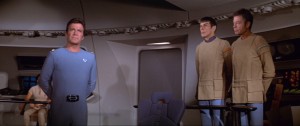 I’m fascinated by this because this music accompanies what is probably the most original-series-esque moment of the film; the end scene where the crew are back on the bridge, reflecting on what has just transpired. The music finishes with restatements from Goldsmith’s piece “The Enterprise” as the ship majestically warps on to her next mission. Steiner and Courage worked together on two tracks for the film. “Captain’s Log/Warp Point 8” which features Kirk’s log followed by the Enterprise’s first attempt at warp speed (which results in their being flung into a wormhole) and “Captain’s Log/Warp
I’m fascinated by this because this music accompanies what is probably the most original-series-esque moment of the film; the end scene where the crew are back on the bridge, reflecting on what has just transpired. The music finishes with restatements from Goldsmith’s piece “The Enterprise” as the ship majestically warps on to her next mission. Steiner and Courage worked together on two tracks for the film. “Captain’s Log/Warp Point 8” which features Kirk’s log followed by the Enterprise’s first attempt at warp speed (which results in their being flung into a wormhole) and “Captain’s Log/Warp 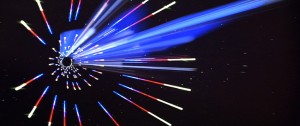 Point 9″ which again has Kirk’s narration before the ship’s successful warp flight. What’s interesting to note here is that Steiner composed music for the Enterprise’s acceleration which is rousing and driving. It was decided, however, to only bring the music up at the end to make it more dramatic. Probably the best choice from a cinematic standpoint, but the music is well-written and performed regardless.
Point 9″ which again has Kirk’s narration before the ship’s successful warp flight. What’s interesting to note here is that Steiner composed music for the Enterprise’s acceleration which is rousing and driving. It was decided, however, to only bring the music up at the end to make it more dramatic. Probably the best choice from a cinematic standpoint, but the music is well-written and performed regardless.
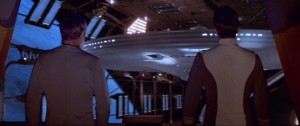 But the complete score is only the first fantastic morsel in this masterpiece collection. After you are presented with the full score (which takes up all of disc one and 2 tracks on disc 2), you are met with multiple “early versions” of the film’s music. Most notable here are the pieces for “The Enterprise” and “Leaving Drydock”. Both pieces were composed before the flim actually had a theme (an oversight on Goldsmith’s part as explained in the liner notes). Both tracks feature a driving nautical sound which is very reminiscent of ships on the high seas. They are brilliantly crafted by Goldsmith and are fantastic pieces of music in their own rights. However, as director Robert Wise pointed out at the time, they are missing a central theme. And it is because of these pieces that theStar Trek motion picture theme was created.
But the complete score is only the first fantastic morsel in this masterpiece collection. After you are presented with the full score (which takes up all of disc one and 2 tracks on disc 2), you are met with multiple “early versions” of the film’s music. Most notable here are the pieces for “The Enterprise” and “Leaving Drydock”. Both pieces were composed before the flim actually had a theme (an oversight on Goldsmith’s part as explained in the liner notes). Both tracks feature a driving nautical sound which is very reminiscent of ships on the high seas. They are brilliantly crafted by Goldsmith and are fantastic pieces of music in their own rights. However, as director Robert Wise pointed out at the time, they are missing a central theme. And it is because of these pieces that theStar Trek motion picture theme was created.
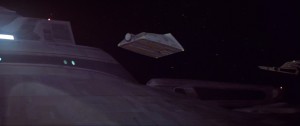 Another early track that was included is a much-earlier version of “Spock’s Arrival” which was written before Goldsmith had come up with the “Total Logic” theme for Spock. Because of this, the music is much more in line with Goldsmith’s earlier treatment for “The Enterprise”. Once again the music is brilliantly crafted and evokes the sea (a piece of connective tissue from Goldsmith showing that Spock would now join the Enterprise) but was ultimately not suited for the tone of the film and the scene. Goldsmith later gave this music new life in Star Trek V: The Final Frontier where it was reworked for the Entreprise’s first appearance in the film.
Another early track that was included is a much-earlier version of “Spock’s Arrival” which was written before Goldsmith had come up with the “Total Logic” theme for Spock. Because of this, the music is much more in line with Goldsmith’s earlier treatment for “The Enterprise”. Once again the music is brilliantly crafted and evokes the sea (a piece of connective tissue from Goldsmith showing that Spock would now join the Enterprise) but was ultimately not suited for the tone of the film and the scene. Goldsmith later gave this music new life in Star Trek V: The Final Frontier where it was reworked for the Entreprise’s first appearance in the film.
The early version of the track “Inner Workings” is an old Easter Egg for me. I first heard this piece of music excerpted in the first teaser trailer for Star Trek: Generations. The piece was clearly Goldsmith and clearly from TMP, but I never heard it in the film. Then, when the Star Trek: The Motion Picture – The Director’s Edition DVD was released, I heard the music again during the scene where Ilia helps to soothe Chekov’s pain after he has been electrocuted by the overloaded console. Finally the piece is included, in its entirety.
Next up on the 3-disc set is the original album presentation of the soundtrack as it was released in 1979. This has become de rigueur for these releases and I am not complaining. For completists, the track “Vejur Flyover” is even misspelled exactly as it was in the original release.
Disc 3 then has more alternate takes and additional music. About 75 minutes’ worth, in case you’re wondering. Included is a version of the “Main Title” which I lovingly call the “more cowbell version”. There is not discernable cow bell, BUT there are more pronounced ‘church bells’ throughout the piece, which I actually find enhances the music. There is also included what is called the “discrete” version to Steiner’s “A Good Start” which allows you to hear the piece as it was originally recorded with a clean solo horn opening.
Next is the true gem of this collection. Included is the very first performance of the main title theme by the orchestra, complete with the conductor’s cues and a false start. We’re treated to a few takes of the theme complete with the occasional flub. It’s the best you can ever expect as behind-the-scenes goodies on a soundtrack release. Additional behind the scenes audio can be found in excerpts from “The Force Field/The Cloud”.
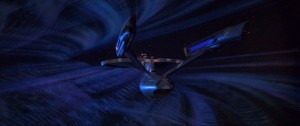
The Blaster Beam became THE sound for V’Ger
3 tracks are devoted to Craig Huxley’s work with the Blaster Beam. Huxley created the Blaster Beam was first heard in Mel Brooks’ High Anxiety but was used most prominently as the voice/sound of V’Ger in Star Trek: The Motion Picture. Huxley, who had also appeared as a child actor on the original Star Trek and also provided the music for the Genesis sequence in Star Trek II: The Wrath of Khan was primarily responsible for all synthesized sounds in the TMP score. It’s amazing to hear this stuff raw and I recommend it as a study in how seamlessly the work melded (pun intended) with Goldsmith’s orchestral work.
Rounding out the set are two complete oddities. The first is a reworking of the TMP Main Title as realized by Bob James (the briliant mind behind “Angela”, otherwise known as the “Theme from Taxi”). The piece is a bit more disco than I am used to from James’ work, but at one point the end result is reminiscent of the showcase music from The Price is Right. I’m not sure exactly how evocative of Goldsmith’s work this piece winds up being (it lapses, mercifully, into disco-y/jazzy melodies), but it’s worth listening to at least once nonetheless.
Then there is the track “A Star Beyond Time.” This was an attempt to turn “Ilia’s Theme” into a vocal song sung by Shaun Cassidy. According to the liner notes, the song was only released as a 45 rpm promotional record sent to radio stations and theaters in Japan. I think that’s probably all you really need to know about this piece of music. It almost makes Shatner’s singing sound palatable. It’s not Cassidy’s fault, however. The lyrics are just that terrible.
Overall, this release is worth it’s weight and so much more. It’s a stunning tribute to the work of Jerry Goldsmith, making what was old new again. Hearing is never-before-released/used tracks is a true treasure. And to hear the orchestra’s first attempts at bringing such a celebrated piece of music to life are like witnessing history in the making. Let’s not forget that the this seminal piece of music not only represented this film, but 4 other Star Trek films and Star Trek: The Next Generation. Second only to Alexander Courage’s theme, this music is MOST associated with Star Trek and has endured the longest.
With this release, there are now expanded-edition soundtracks for all 6 of the original Star Trek films. Now if only someone could get all the music from the original series…